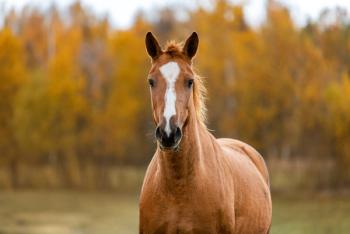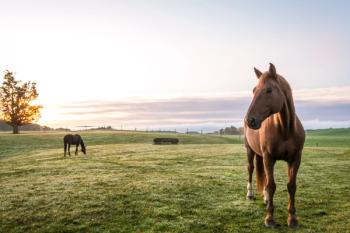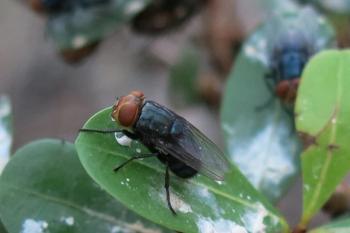
Managing grief responses
Any time a horse dies, other horses that might have been close to the deceased horse should be allowed to spend time near it.
Ben and Doc had been together for a long time. They were born in the same area, lived together and actually worked side by side for many years. They retired to the same place and had been spending their elderly days quietly. But when Doc became ill and then quickly died, Ben was devastated. He stopped eating, didn't want to move around much or to do any of the things that had occupied his previous days. He wouldn't interact with anyone around him, and he became severely withdrawn. Without his friend to do things with, he became inactive and started losing weight and muscle condition. His arthritis, which had been doing well, became worse. Not eating enough began to weaken his energy and his immune system. He started to become anemic and dehydrated and showed all the signs of physical and psychological depression.
This is not an unusual scenario, and the loss of a close friend or a loved one can be seriously stressing to people, especially to the elderly. But Ben and Doc are horses. While the "stress of loss" is not commonly addressed in equine veterinary medicine, it still can be a very real problem and a cause of concern to equine clients.
Instinct vs. emotion
Loss and bereavement is more commonly dealt with as it applies to the feelings our clients have after losing a pet. Veterinarians have become so aware of their special role in this potentially devastating event that some clinics and veterinary schools now have grief counselors. There are many reference sources, support groups and even "pet loss" chat rooms to help people deal with this trauma.
But there is almost nothing written and virtually no research, surprisingly, dealing with the reaction of animals to the loss of a partner or close herd mate. Animal behaviorists caution that it is not always correct to think and speak anthropomorphically (giving human feelings and characteristics to animals,) but owners and trainers say they can tell when a horse is feeling happy, playful, contented, angry, bored, tired, upset or any number of other emotions. And most veterinarians, even if they do not use these terms, recognize similar behavioral expressions. In cases like Ben and Doc, the surviving horse often shows signs of classical depression and, in the words of most of our clients, acts sad.
However, there may be more science to the way animals seem to act, and Dr. Sharon Crowell-Davis, DVM, Ph.D. and board certified animal behaviorist at the University of Georgia College of Veterinary Medicine, assures us that these interpretative evaluations of how animals "feel" in response to certain situations are fairly accurate.
"The use of PET scans (positron emission tomography) provide researchers with an evaluation of mental states based on brain activity and neurochemical changes noted in response to specific stimuli," Crowell-Davis explains.
A person is presented with a stimulus that causes them to be happy, for instance, and the PET scan records his or her pattern of brain activity and chemical changes that occur in the brain during that time period. Additionally, certain drugs can be given that produce specific feelings, and the resultant brain activity and chemistry can be recorded.
"When animals are recorded showing the same patterns of brain activity and the same brain chemical changes that correspond to a particular human emotion or mood state, it would not be logical of us to assume that they are not experiencing similar feelings," Crowell-Davis says.
Clinical concerns
Based on how closely some horses correspond to the classical signs of clinical depression and on how intense the individual responses can be, the loss of a close companion is felt as sadness by horses, and they certainly can express grief.
While it is not known how animals interpret or understand death, many owners and veterinarians say there is some form of comprehension. When one of a pair of horses dies, the remaining horse might be severely affected or might show little response.
Dr. K. Houpt, DVM, Ph.D., physiologist and animal behaviorist at the New York State College of Veterinary Medicine at Cornell University, points out that there is a tremendous variation in the amount of attachment shown by individual horses.
"Some horses tend to form stronger and more numerous 'friendships', " he says. In the attachment shown for a particular individual, "a specific horse may be extremely bonded to one other horse and yet exhibit no concern for other horses in the same group."
Equine maternal behavior follows this pattern of variability as well. When a young foal dies, the mare can respond strongly with vocalization, anxiety and frenzied activity. This response may be mild to severe and will last for differing durations depending on the mare.
Behavioral treatment
Both Drs. Houpt and Crowell-Davis recommend allowing the mare to spend time with her dead foal. Most mares will examine the foal and move away, return, and move away again. Depending on the variability of the individual, this process will take several hours but the mare eventually will begin ignoring the foal and it then can be removed. Mares treated in this way show much less vocalizing and anxiety. They grieve and, "As far as we can tell at this point, they come to some realization of death," Crowell-Davis says.
But any time a horse dies, it is recommended that other horses that may have been close to the deceased horse be allowed to spend time near it. The "grief response" seen in horses given this opportunity seems to be lessened, and the amount of time until a return to near-normal behavior is far shortened.
But even when allowed to spend time with a departed herd mate, some horses, like Ben in our example, show an exaggerated depth of depression and can present with physical problems that are really physiologically based. The appropriate treatment for these horses is similar to that used with depressed humans. Supportive therapy should address any metabolic concerns, such as arthritis, dehydration and poor food intake. Behavioral treatment is aimed at getting the horse interested in its environment again. Special foods, increased play and interaction with the owner (even something as simple as additional grooming can be very beneficial) and communication with other horses might be required. The introduction of other horses may be problematic, however, as some horses, especially older animals, might resent new herd mates and this additional stress can worsen the situation. Dr. Houpt recommends adding a new horse to the herd, when possible, before one of an older pair of horses becomes ill. This is not always possible, but if early illness is noted, then another horse can be added to the group so there is a pre-existing bond with this new horse to help with the loss of an older herd mate.
Many owners and trainers can identify this "universally acceptable" herd mate on their farm. This is a special horse that seems to get along with every animal and be liked by every animal. This is the older gelding that serves as companion for all weaned foals and is the first horse that newcomers to the farm are turned out with. It is not known why these special horses are so accepted, but they make excellent choices for the horses to introduce to a pair of ailing geriatrics or other situations where one horse might die soon. It is important to pair-up horses of similar dispositions and activity levels, and care and attention should be paid to choosing a new mate for a horse that is soon to lose an old mate.
Medical options
If behavioral treatment is not sufficient, then medical treatment might be needed. This is especially true for those horses that show such severe grief that they are in danger of colic, anemia, dehydration and kidney problems or of any other metabolic concerns made worse by clinical depression. Initial treatment with valium can lessen anxiety and stimulate appetite. Because this drug produces a quick effect, it is most commonly used as the first step in treatment at a dose of 10-30 milligrams given every four hours in the feed. Fluoxentine hydrochloride (Prozac) is the drug that then would be used as a longer-term treatment. Prozac is much slower acting and is given at 80 mg daily, but the dose may be titrated up to two to 10 times that amount as needed. This combination of valium followed by fluoxentine hydrochloride has been helpful in lessening the extreme grief and depression seen in some horses. Methylphenidate (Ritalin) also has been tried as a means of decreasing anxiety but is not as rewarding as the valium/Prozac approach. After horses return to more normal activity while on the Prozac, herd additions can be made and if successful, the dosage of Prozac can be gradually decreased and then discontinued.
Anyone who has spent time around horses will tell you that they can be happy, pleased, angry or mean. They do have emotions, and they certainly can interact with their environment and feel things. When horses die, other horses close to them exhibit grief-like behavior, which can become excessive at times. Recognition of this phenomenon is important for equine veterinarians because clients will seek help in dealing with these situations. Being aware of grief loss in horses and being willing to help treat these situations will allow you to help both horses and their owners. It is likely that we eventually will find that many behavioral and emotional states currently assigned only to humans, such as paranoia, schizophrenia, attention deficit disorders and many others also are all found in horses. Their recognition, diagnosis and treatment will help improve life for many horses that currently are thought of as "untrainable", "spooky", or simply "crazy". It actually might be far crazier to assume that these horses do not feel many of the same things that we do and need treatment just as much.
Newsletter
From exam room tips to practice management insights, get trusted veterinary news delivered straight to your inbox—subscribe to dvm360.






